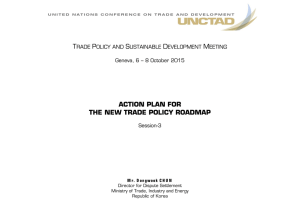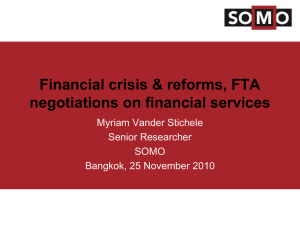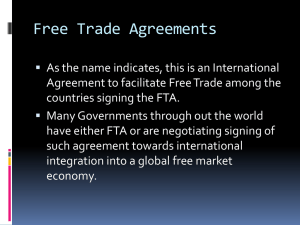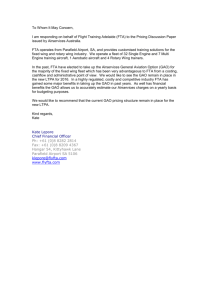Ms. Jiangning Wang Director Department of International Economic and Trade Relations
advertisement
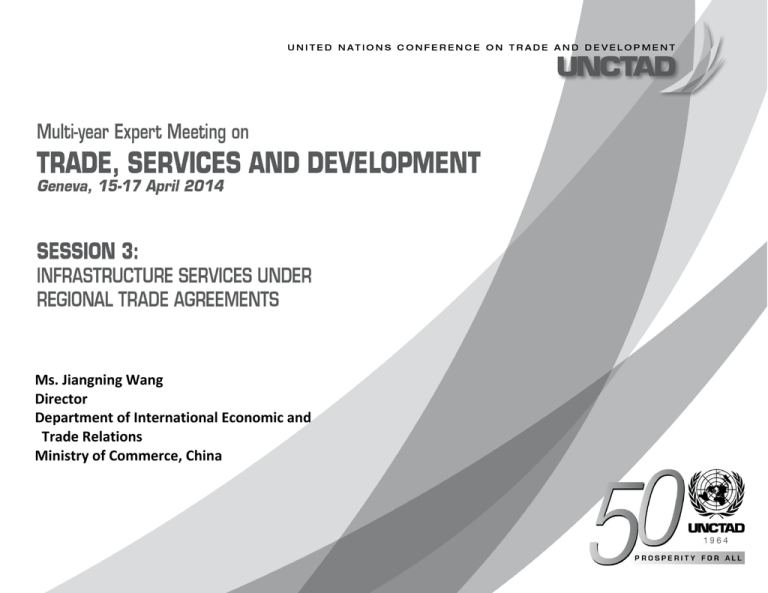
Ms. Jiangning Wang Director Department of International Economic and Trade Relations Ministry of Commerce, China Infrastructure Services under China’s FTAs UNCTAD Geneva 16 April 2014 WANG Jiangning Ministry of Commerce, China Infrastructure Services under China’s FTAs Content Ⅰ Global FTA Development Trend Ⅱ Introduction of China’s FTA Ⅲ ISS under China’s FTA Ⅳ A Few Thinking I Global FTA Development Trend 1948-2014 Global FTA Development 35 30 1948-1999, 29 2008; 27 25 2012; 21 20 2013; 19 2009; 18 15 2011; 15 2004; 13 2001; 12 10 2003; 9 2000; 7 5 0 1998 2000 2007; 11 2005; 8 2010; 11 2006; 10 2002; 6 2002 2004 2006 2008 2010 2012 2014 I Global FTA Development Trend FTA Mode Mode Quantity bilateral FTAs 150 plurilateral FTAs 67 cross-regional FTAs 109 intra-regional FTAs 108 developed-developed FTAs 17 developed-developing FTAs 90 developing-developing FTAs 110 I Global FTA Development Trend FTA situation of main areas North Latin East America America Asia North America Latin America East Asia South Asia Europe Soviet Union Middle East Oceania Africa South Asia Europe Soviet Middle Oceania Africa Union East 1 - - - - - - - - 10 22 - - - - - - - 2 17 15 - - - - - - 0 0 7 4 - - - - - 1 10 5 0 19 - - - - 0 0 0 0 4 35 - - - 7 2 2 0 23 0 8 - - 1 2 11 0 1 0 0 3 - 0 0 0 0 5 0 1 0 1 I Global FTA Development Trend Mega FTAs change the world 61% 37% I Global FTA Development Trend Economic indicators of large-scale FTAs Foreign Trade Population Membe (100 r million) % GDP Foreign Investment Attraction % Flow Export % Import 61% Stock % Amount % Amount % World 70.8 100 71.9 100 18.4 100 18.6 100 1.4 100 22.8 100 TPP (12) 8.0 11.3 27.5 38.2 4.4 23.6 5.2 27.9 0.4 30.0 7.0 30.5 RCEP (16) 34.0 48.0 21.3 29.6 5.2 28.5 5.2 28.1 0.3 24.4 3.4 15.0 TTIP (29) 8.3 11.7 32.3 44.9 7.3 39.9 8.3 44.5 0.4 31.6 11.8 51.6 CJK 15.3 30.8 15.4 21.4 3.4 18.5 3.2 37% 17.3 0.1 9.8 1.2 5.2 NAFTA (3) 4.8 6.8 18.7 26.0 2.4 12.9 3.2 17.2 0.2 16.7 4.9 21.4 I Global FTA Development Trend 2001-2012 EU/US V.S. BRICS GDP and Trade Proportion Comparison 61% 37% I Global FTA Development Trend Global economic and trade rules reconstruction 61% New Rules At-theboarder: Trade in goods, trade in services, government procurement, etc. Behind-the-boarder: IPR, Regulation Consistency, Competition(SOEs), etc. 37% 21st Century issues: E-commerce, environment, labor standards, human rights, etc. II Introduction of China’s FTA II Introduction of China’s FTA 12 Signed 18 FTAs with 31 countries & districts 10 Implemented 6 Under negotiations Finished JFS with India and Sri Lanka, undertake JFS with Colombia and Israel. II Introduction of China’s FTA China’s Signed FTA Overview Agreement Entry into Effect Tariff Tariff eliminated after a transition eliminated period % Trade in from the date entry into Tariff Import Duration Services Investment Other rules force % China-ASEAN 2005 8.4% 94.3% 93.2% 10 years China-Chile 2006 37.2% 97.2% 90.6% 10 years China-Pakistan 2007 8.4% 35.5% 40% 5 years China-New 2008 24.1% 97.2% 96.3% 12 years China-Singapore 2009 9% 94.3% 97% 10 years China-Peru 2010 61.2% 94.6% 99% 17 years China-Costa Rica 2011 65.3% 96.7% 99% 10 years China-Iceland N/A 95.6% 96% 100% 10 years China-Switzerland N/A 22.8% 92.1% 84.2% 15 years Zealand Most = DDA commitment s Preestablishment NT & Few negative list involved. are not involved. II Introduction of China’s FTA Trade between China and FTA Partners (excl. Taiwan, Hong Kong, Macao) II Introduction of China’s FTA 2005-2012 ASEAN’s Foreign Trade Export Import Total Year 2005 2012 2005 2012 2005 2012 China 7.4% 11.3% 9.3% 14.5% 8.35% 12.9% U.S. 14.2% 8.6 % 12% 7.5% 13.1% 8.1% E.U. 13.2% 10.0% 11.3% 9.6% 12.25% 9.8% Japan 12.3% 10.1% 15.8% 11.2% 14.05% 10.6% Korea 3.8% 4.4 % 4.5% 6.2% 4.15% 5.3%% ISS under China’s FTAs • China-ASEAN FTA • Agreement on Trade in Services implemented form July 2007. Parties’ WTO plus commitments on ISS: • China-construction and road transport services; Singapore-transport services; Malaysia-telecom, construction and transportation; Indonesiaconstruction and energy services; Thailand-maritime and movement of natural persons; the Philippines-energy services; Brunei-transportation. • Agreement on Investment signed on August 2009. • Working Group on Economic Cooperation set up under the Implementation of CAFTA • China and ASEAN are consulting a “upgraded CAFTA” possibly cover China-ASEAN connectivity. ISS under China’s FTAs • China-Chile FTA • On April 2008,China and Chile signed the Supplementary Agreement of China-Chilean Free Trade Agreement on Trade in Service • China made further commitments to Chile on 23 sectors and subsectors, including computers, management consultation, mining, environment, sports, air transportation • Chile made further commitments to China on 37 sectors and subsectors, including legal services, construction, engineering, R&D, real estate, advertising, management consultation, mining, manufacturing, leasing, distribution, education, environment, tourism, sports and air transportation. • . ISS under China’s FTAs • China- New Zealand FTA Both parties signed the FTA on April 2008. China:made more liberalized commitments to New Zealand in 4 sectors( 15 sub sectors) compared with its WTO commitments, including business services, environment, sports, and transportation. New Zealand: made more liberalized commitments to China in 4 sectors( 16 sub sectors) than to WTO, including business services, construction, environment and education. Both sides will grant MFN treatment to each other in 7 areas (environment, construction, agriculture and forestry, engineering, integrated engineering, computer, tourism) so as to ensure that the services or service suppliers of the other Party could enjoy no less treatment as a Third Party on like services • ISS under China’s FTAs • China- New Zealand FTA Movement of Natural Persons New Zealand will provide 800 work permits to 5 professions including Traditional Chinese Medicine practitioners, Chinese chefs, Chinese teachers, Wu Shu Coaches, Chinese tourism guides,and recognize the diplomas and working experiences;1000 work permits for 20 professionals including turners, boiler makers, electricians, plumbers, computer engineers, auditors. 1000 young Chinese every year will get working visas under the Working Holiday Scheme. up to date, more than 6000 Chinese to be granted a working visas to get entry to New Zealand under China-New Zealand FTA. ISS under China’s FTAs • China- Singapore FTA Financial Services Both Parties signed the Agreement in 2008. In 2012, both parties signed an arrangement on Banking Services under the CSFTA. • A bank license with Qualifying Full Bank privileges in Singapore shall be granted by the relevant Party to each of 2 eligible Chinese banks; • One Chinese bank with QFB privileges in Singapore shall be authorized by the relevant Party as a clearing bank for Renminbi in Singapore as soon as reasonably practicable after the granting of the bank licence with QFB privileges to both of the 2 eligible Chinese banks. ISS under China’s FTAs RCEP •Launched negotiation in 2012, and 4 round s of negotiations concluded. •TNC, and working groups on TIG, TIS, Investment, Economic and Technical Cooperation, IPR, Competition, Dispute Settlement have been set up. •ASEAN’s centrality •ASEAN & AFP •Open and Progressive •On the base of 5 ASEAN Plus One FTAs IV A Few Thinking ISS’ s role in China’s FTAA 2 ISS have become a major feature of 21st century FTAs that are oriented towards deeper and comprehensive integration with a strong regulatory focus, especially to the improvement of global value chains 4 ISS Effects on FTA Economy of Scale FTAs to get rid of the existing market barriers, gain economies of scale and a stable market. ISS Effects on FTA Promotion of Competition Market competition could help companies improve production efficiency. According to EU’s experience, 1% increase of economic openness = 0.6% increase of productivity. ISS Effects on FTA Investment Effect Eliminating barriers to goods, services, capital and other factors could inspire investments among regional members. Elimination of tariff and non-tariff barriers could also help attract investment from countries out of the region and expand exports to other members. Website of China’s FTA Network http:fta.mofcom.gov.cn 感谢 thanks 26 国际司

